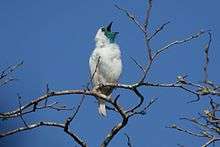Bare-throated bellbird
| Bare-throated bellbird | |
|---|---|
 | |
| In Paraná, Brazil. | |
| Scientific classification | |
| Kingdom: | Animalia |
| Phylum: | Chordata |
| Class: | Aves |
| Order: | Passeriformes |
| Family: | Cotingidae |
| Genus: | Procnias |
| Species: | P. nudicollis |
| Binomial name | |
| Procnias nudicollis (Vieillot, 1817) | |
The bare-throated bellbird (Procnias nudicollis) is a species of bird in the family Cotingidae. It is found in moist subtropical and tropical forests in Argentina, Brazil, and Paraguay. The male has white plumage and bristly bluish-black bare skin around its eye, beak and throat. The female is more drab, being olive-brown above with streaked yellow underparts. The male has one of the loudest bird calls known, producing a metallic sound similar to a hammer striking an anvil. This bird feeds on fruit and plays a part in dispersing the seeds of forest trees. It is considered a vulnerable species because of loss of its forest habitat and collection for the pet bird trade.
Description
The male bird has striking white plumage and a bare bluish-black patch of skin around its eyes and beak and on its throat. The female is duller in colour with a black crown, olive-brown upper parts and yellowish underparts streaked with olive green. This bird is about 27 cm (11 in) long.[2]
The male has one of the loudest calls of any bird - a sharp sound like that of a hammer striking an anvil or a bell, emitted by the male while it perches on a high branch in order to attract a mate.[2] The sound is so loud, that it can be heard up to a mile away and can apparently cause damage to human hearing if heard from close range.
Distribution
The bare-throated bellbird is a native of Brazil, Paraguay and Argentina. Its natural habitats are subtropical or tropical moist lowland forests and subtropical or tropical moist montane forests.
Behavior
It is threatened by habitat loss and by poaching for cage birds.[1] It raises the attraction of collectors because of the adult males's showy coloration (shiny white with the skin of the throat bare and turquoise blue; the female, as well as both sexes juveniles, are mostly light or olive green with a black head). A fruit-eating species, it acts in the ecology of the Atlantic rainforest as a dispersor of seeds.[3] Despite its vulnerable status, it can be found in an unusual urban setting, a juvenile male having recently (2007) been photographed foraging in one of the campuses of the Federal University of Rio de Janeiro set in an artificial island in the vicinity of the heavily polluted Guanabara Bay;[4] another specimen had already been spotted in 2005 at the Ibirapuera Park in São Paulo [5]
References
- 1 2 BirdLife International (2012). "Procnias nudicollis". IUCN Red List of Threatened Species. Version 2013.2. International Union for Conservation of Nature. Retrieved 26 November 2013.
- 1 2 "Bare-throated bellbird fact file". ARKive. Retrieved 12 January 2016.
- ↑ Prefeitura.sp.gov.br - Municipality of São Paulo site, in Portuguese Archived December 10, 2007, at the Wayback Machine.
- ↑ Guiserpa.com - Brazilian birdwatcher's photographic site Archived July 14, 2011, at the Wayback Machine.
- ↑ "Estudo revela 120 espécies de ave no Ibirapuera" ["Study uncovers 120 bird species at Ibirapuera"]Folha de S.Paulo, 12th. October 2005
Further reading
- Snow, D.W. (1982). The Cotingas: Bellbirds, Umbrella birds and their allies. British Museum Press. ISBN 0-19-858511-X
